 Click To Return To Main Page |
 |
||||||||
 News |
 Eco-Journalists |
 Articles |
 Games |
 Links |
 Facts 'n Fun |
 Email Us |
 About Us |
 Guestbook |
|
|
Bacteria and the Black Death
The bacteria 'Yersinia pestis' causes Plague.
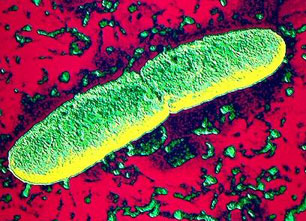
Ratus Ratus
 There's good bacteria and there's bad bacteria....and then there's bacteria which cause about a third of Europe to be wiped out (that's 25 million people in five years!!!!!)
There's good bacteria and there's bad bacteria....and then there's bacteria which cause about a third of Europe to be wiped out (that's 25 million people in five years!!!!!)
Ring a ring a rosies, a pocket full of posies, atishoo, atishoo, we all fall down. This innocent nursery rhyme is really a rhyme of death... The black death or Bubonic Plague. The sores and 'buboes' of the Plague
- fake in this case!  The first symptoms of the black plague was a ring of small red spots (usually on the arm), this is the 'ring of rosies' in the rhyme. A pocket full of posies comes from the fact that back in the late 1600's, they believed that bad smells caused the plague, therefore they must carry sweet smelling petals with them to ward off the plague. Atishoo, atishoo was the sneezing which was also a symptom of the plague. We all fall down... well, that might look cute to see little kids do it, but it's actually acting out the last stage of the plague, when people die.
The first symptoms of the black plague was a ring of small red spots (usually on the arm), this is the 'ring of rosies' in the rhyme. A pocket full of posies comes from the fact that back in the late 1600's, they believed that bad smells caused the plague, therefore they must carry sweet smelling petals with them to ward off the plague. Atishoo, atishoo was the sneezing which was also a symptom of the plague. We all fall down... well, that might look cute to see little kids do it, but it's actually acting out the last stage of the plague, when people die.
Eyam, where villagers bravely stopped
the spread of the Plague. 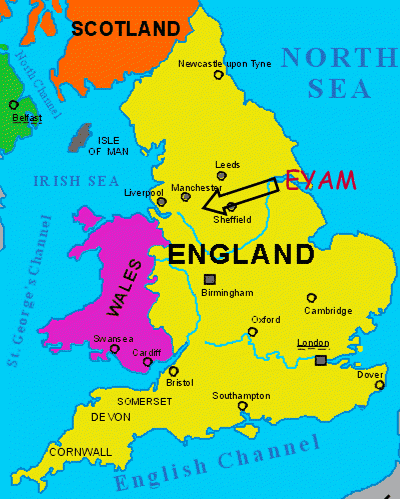 We learnt a lot about the plague when we went to England on holiday and visited Eyam, in Derbyshire. This was the last place in England to be infected with the plague in 1665. Fleas can hibernate (sleep) in cloth for as long as 6 months. The plague was bought into Eyam by a merchant selling cloth. The cloth obviously had fleas in it.
We learnt a lot about the plague when we went to England on holiday and visited Eyam, in Derbyshire. This was the last place in England to be infected with the plague in 1665. Fleas can hibernate (sleep) in cloth for as long as 6 months. The plague was bought into Eyam by a merchant selling cloth. The cloth obviously had fleas in it.
The amazing thing about Eyam is that the people knew it would spread if they fled from the village, so they decided to stay, cut off from the rest of the world. It was a very brave thing to do and probably saved 1000's of lives even though it meant 80% of the village population died with whole families wiped out. They painted a red cross on a person's door when they had the plague. The worst place to be was London. The King, Charles II, left London and stayed in Oxford instead. No one was safe, but the poor people were the worst because they lived in cramped, unclean conditions. 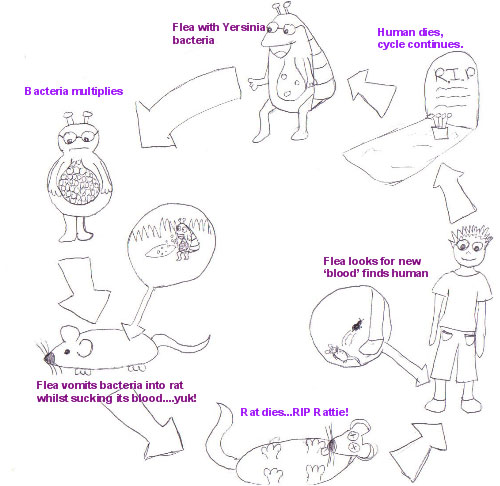
Fleas carried the pestis bacteria.
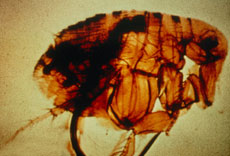 It is said that the rats were the cause, but actually the rats were just the carriers of the plague. Fleas lived on the rats, and the bacteria on some of the fleas had the virus.
It is said that the rats were the cause, but actually the rats were just the carriers of the plague. Fleas lived on the rats, and the bacteria on some of the fleas had the virus.
The people of London in believed it was the cats and dogs who were causing it and killed them all off. (of course, they were the only thing that could have actually stopped the plague, as they kill rats.) The bacteria inside the flea's stomach is usually harmless, but for a reason that even scientists do not know, the bacteria suddenly can multiply and clog up the flea's stomach. It then 'throws up' and vomits the bacteria out while feeding on an animal. The 'puke' goes into the animal's bloodstream, causing it to die. The flea then hops it and looks for something else warm and living to feed on.....often a human, so it then spreads the bacteria by biting and feeding. Map showing areas of Europe affected by Black Death.
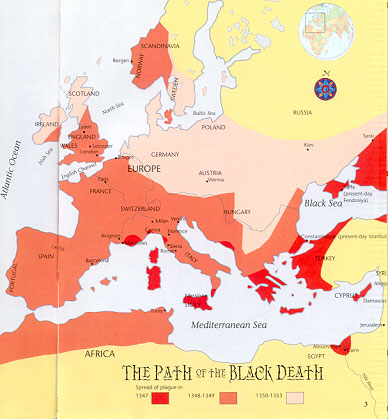 The bacteria is called 'Yersinia pestis'. It causes the black boils which is why it's called the 'Black Death'. These boils are actually blood under the skin caused by internal bleeding, the bacteria then spreads to the lungs which fill with frothy blood which the person drowns in....yuk! Big swellings appeared called 'buboes' this was a sign the disease was spreading and the body's immune system couldn't fight it.
The bacteria is called 'Yersinia pestis'. It causes the black boils which is why it's called the 'Black Death'. These boils are actually blood under the skin caused by internal bleeding, the bacteria then spreads to the lungs which fill with frothy blood which the person drowns in....yuk! Big swellings appeared called 'buboes' this was a sign the disease was spreading and the body's immune system couldn't fight it.
Some people just didn't catch the plague and there's a man called Dr Stephen O'Brien who thinks he's found that a gene (the 'code' in our bodies which tells our bodies what to do) which stops some people catching it. He thinks it's the same reason some people can't catch AIDS. It's called 'Delta 32'. This is very exciting as if we could copy Delta 32 it would mean that millions of people would not get HIV/AIDS and maybe other diseases. When the rat carrying the flea died,
the flea hopped onto another victim and so spread the disease again.  It's so interesting that I really recommend you go to: www.pbs.org/wnet/secrets/case_plague/ where you can read lots more about Dr O'Brien and the history of Delta 32 and how it stopped Europeans being wiped out. If you're from Africa or China you won't have Delta 32 so don't go near any flea-infested rats!
It's so interesting that I really recommend you go to: www.pbs.org/wnet/secrets/case_plague/ where you can read lots more about Dr O'Brien and the history of Delta 32 and how it stopped Europeans being wiped out. If you're from Africa or China you won't have Delta 32 so don't go near any flea-infested rats!
When in Eyam we visited the Eyam museum which was very interesting but had a very bad tempered woman on the front desk, who kept attacking us so it spoilt the visit a bit. In fact mum couldn't get out of there quick enough! Fortunately, there's a nice shop next to it which sells lovely English lollies and has a nice man running it, so that cheered us up a bit. By Freya Wadlow Ref: www.pbs.org/wnet/secrets/case_plague www.cressbrook.co.uk/eyam/museum/ www.themiddleages.net/plague.html Images: rat: thecrazynewsblog.com plague face: www.bellbookcamera.com dead rat: www.emedicinehealth.com plague map: www.tomecek.com bacteria: webs.wichita.edu - the learning company map: uk.filo.pl |